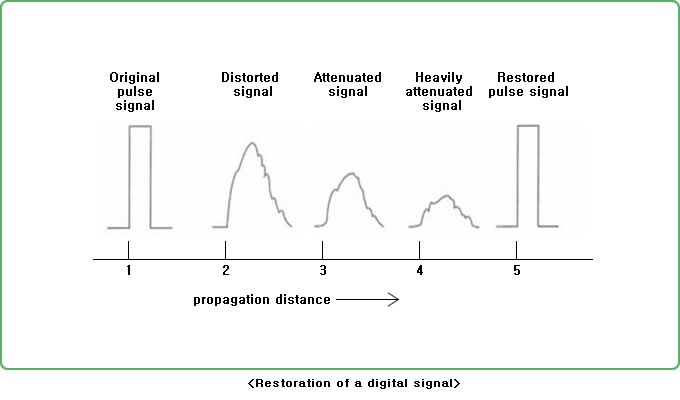
Representation of a digital signal
-
- Properties of a digital signal
- Merits of a digital signal
- Easier to regenerate its original signal
- Stronger against distortion, and interference or jamming from other sources
- Jamming : someone intentionally enter a user’s signal or putting a disturbance signal into a user’s signal
- Obtainable high fidelity (due to regenerating of its original signal by coding)
- High reliability, low cost, easier to implement in hardware
- Easier to process and store digital data
- Weak points of a digital signal
- Requires additional steps to process a digital signal
- A/D converting, sampling, quantization, encoding, and D/A converting
- A digital signal requires wider bandwidth
- Requires synchronization in digital signal processing
- Synchronization : a step to match the starting point of data
-
- Properties of a digital signal
Let us look at the properties of a digital signal. A digital signal is widely used because of its merits. First, it is easier to regenerate its original signal. This means that if a digital signal experiences noises and is attenuatted, the signal can be restored because the digital signal has two level values.
Second, it is stronger against distortion, and interference or jamming from other sources. Jamming is someone intentionally enters a user’s signal or putting a disturbance signal into a user’s signal. Third, it is obtainable for high fidelity, due to regenerating of its original signal by coding. Forth, a digital signal has high reliability, low cost, and is easier to implement in hardware. And fifth, it is easier to process and store digital data.
The signal can be distorted due to the channel limitations or phase interferences. The restoration of the signal uses some criteria to decide the attenuated signal to 1 or 0. As you can see in the figure, using a digital signal can provide the perfect restoration from the distorted or attenuated signal.
While a digital signal has merits in telecommunications, the signal also has weak points. First, it requires additional steps to process a digital signal like A/D converting, sampling, quantization, encoding, and D/A converting. Second, a digital signal requires wider bandwidth. Third, it requires synchronization in digital signal processing, synchronization is a step to match the starting point of data.
All the things that we see, hear, and feel are analog signals. Therefore, to handle the signals in digitally, the analog signals should be converted to their corresponding digital signals. Some information may be lost in this process, but we can restore some of the loss in the D/A conversion. And human beings cannot sense a bit of the loss.


